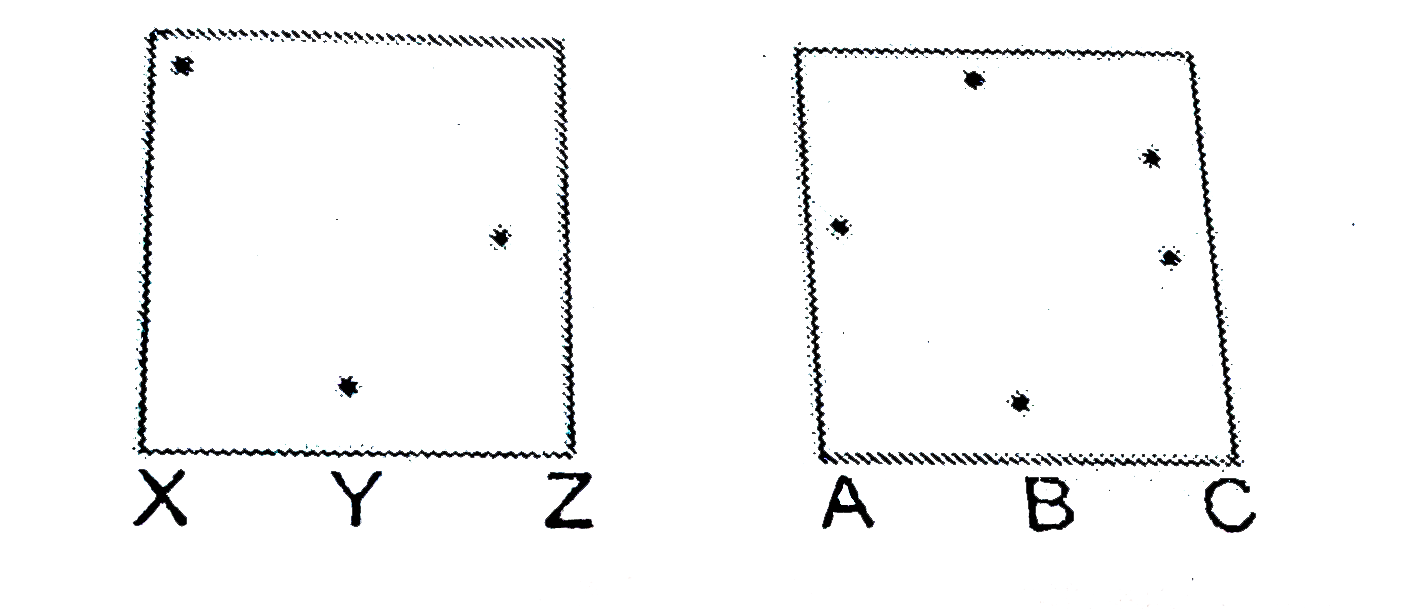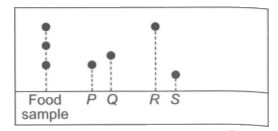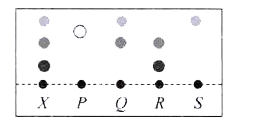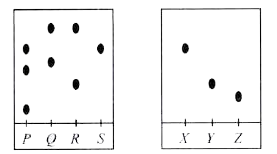A chromatogram of pure samples of food colours X, Y and Z is given in the following illustration 1. Three samples of same food materials A, B and C are analysed for purity, with the help of the chromatogram in illustration 2. Identify the impure sample.

A
B
C
A and C
c
Topper's Solved these Questions
- BOOK - PEARSON IIT JEE FOUNDATIONCHAPTER - NATURE OF MATTER EXERCISE - LEVEL 222videos
NATURE OF MATTER
- BOOK - PEARSON IIT JEE FOUNDATIONCHAPTER - NATURE OF MATTER EXERCISE - LEVEL 310videos
NATURE OF MATTER
- BOOK - PEARSON IIT JEE FOUNDATIONCHAPTER - NATURE OF MATTER EXERCISE - ESSAY TYPE QUESTIONS4videos
NATURE OF MATTER
- BOOK - PEARSON IIT JEE FOUNDATIONCHAPTER - METALS AND NON-METALSEXERCISE - Level-3 Concept Application10videos
METALS AND NON-METALS
- BOOK - PEARSON IIT JEE FOUNDATIONCHAPTER - Organic ChemistryEXERCISE - Level 39videos
Organic Chemistry
Similar Questions
A food sample was tested for the presence of components P, Q, R and S and the following chromatogram was obtained.

The components not present in food sample areView SolutionA sample (A) of water boils at 100∘C whereas another same (B) of water boils at 101.2∘C . Identify the sample which will not freeze at 0∘C .
View Solution
Knowledge Check
- Question 1 - Select One
A drop of a sample of food colouring (X) and four dyes (P, Q, R and S) are put onto a chromatography paper. The four dyes are banned because they are not safe to consume.

Study the given chromatogram carefully and choose the correct statement among the following.AX contains P and Q dyes.BDyes P and S are mixtures of two different dyes.CX contains R dye.DDyes P and R are pure. - Question 2 - Select One
Figure shows activities A of three different radioactive material samples (labelled as I, II and III) versus time. Using the given information, correctly match the requisite parameter in the left column with the options given in right column. Consider only their natural decay as the cause of rate of change of number of parent nuclei

Column-IColumn-II(P) Disintegration constant (λ) has maximum value for the material of sample (1)I(Q)Half life is maximum for the material of the sample(2)II(R)Initially if samples of all three materials have same number of atoms then number of parent atoms of which of the sample will be maximum at any later time(3)III(S)Suppose all the materials decay by emitting α-particles of same energy and initially all three samples contain same amount (in gm) of the materials. Till the end of time span equal to their respective half lives, maximum energy is radiated by the sample(4)it is not possible to compare with the help of data availableAPQRS(A)4234BPQRS(B)2413CPQRS(C)2334DPQRS(D)2143 - Question 3 - Select One
Four samples P, Q, R and S were analysed using paper chromatography to check the presence of three different additives X, Y and Z. The final chromatograms are shown as

Read the following statements carefully.
I. P contains three components out of which one is X II. S contains only one component which is X. III. Q contains two components which are X and Z. IV. R contains two components out of which one is Y. The correct statements areAII and IVBI and IIICI, II and IVDall of these
The following are results of analysis of two samples of the same or two different compounds of phosphorus and chlorine. From these results, decide whether the two samples are from the same or different compounds. Also state the law, which will be obeyed by the given samples.
Amount PAmount ClCompound A1.156 gm3.971 gmCompound B1.542 gm5.297 gmView SolutionThree samples A, B and C of the same gas (γ=1.5) have equal volumes and temperatures. The volume of each sample is doubled, the process being isothermal for A, adiabtic for B and isobaric for C. If the final pressures are equal for the three samples, Find the ratio of the initial pressures.
View SolutionThree samples of the same gas A, B and C (γ=3/2) have equal volume initially. Now, the volume of each sample is doubled. For A, the process is adiabatic , for B, it is isobaric and for C, the process is isothermal. If the final pressures are equal for all the three samples, the ratio of their initial pressures is
View SolutionA student was given a sample of tissue. He observes and concludes the following characters.
(i) The following The cells are composed of a single layer of tall and slender cells.
(ii) Their nuclei are located at the base.
(iii) Free surface may have microvilli .
(iv) It is found in the lining of stomach and intestines
(v) It help in secretion and absorption.
Based on the above features identify the epithelium.View SolutionThree samples of the same gas 'x','y' and 'z', for which the ratio of specific heats in γ=3/2, have initially the same volume. The volumes of each sample is doubled, by adiabatic process in the case of 'x' by isobaric process in the case of 'y' and by isothermal process in the case of 'z'. If the initial pressures of the samples 'x','y' and 'z' are in the ratio 2√2:1:2, then the ratio of theri final pressures is
View Solution

